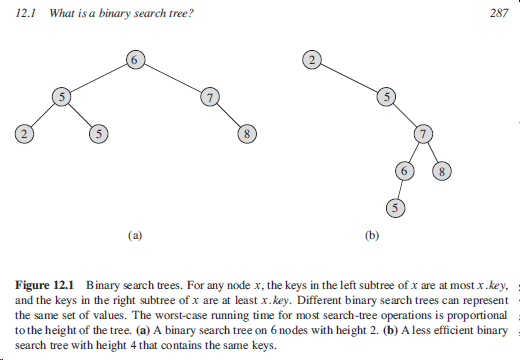概念 Binary Search Tree二叉搜索树的性质: 设x是binarysearchtree中的一个节点。 如果y是x左子树中的一个节点, 那么y.key<=x.key 如果y是x右子树中的一个节点,那么y.key>=x.key

Python Programming # taking the Linked List as the date elements to implement a Binary Search Tree: # left, right, parent class tree_element(): #E: [key, left, right, [parent]], the structure of tree element def __init__(self, E): self.root = E[0] self.key = E[0] self.left = E[1] self.right = E[2] self.p = E[3] class binary_search_tree(list): #[key, left, right, [parent]] # output: [[2, 'NIL', 'NIL', 4], '||', # [4, [2, 'NIL', 'NIL', 4], [5, 'NIL', 'NIL', 4], 6], '||', # [5, 'NIL', 'NIL', 4], '||', # [6, [4, [2, 'NIL', 'NIL', 4], [5, 'NIL', 'NIL', 4], 6], [7, 'NIL', [8, 'NIL', 'NIL', 7], 6], 'NIL'], '||', # [7, 'NIL', [8, 'NIL', 'NIL', 7], 6], '||', # [8, 'NIL', 'NIL', 7], '||'] def __init__(self, keys, parent, left, right, root): # Linked list data structure element # self.keys = [2,4,5,6,7,8] # self.parent = [4,6,4,'NIL',6,7] # self.left = ['NIL',2,'NIL',4,'NIL', 'NIL'] # self.right = ['NIL',5,'NIL',7,8,'NIL'] # self.root = 6 self.keys = keys self.parent = parent self.left = left self.right =right self.root = root def produce_left(self, key): # produce x.key's left child obj ind = self.keys.index(key) if self.left[ind] == 'NIL': return 'NIL' else: El = [] El.append(self.left[ind]) El.append(self.produce_left(self, self.left[ind])) El.append(self.produce_right(self, self.left[ind])) El.append(self.produce_parent(self, self.left[ind])) return tree_element(El) def produce_right(self,key): # produce x.key’s right child obj ind = self.keys.index(key) if self.right[ind] == 'NIL': return 'NIL' else: Er = [] Er.append(self.right[ind]) Er.append(self.produce_left(self, self.right[ind])) Er.append(self.produce_right(self, self.right[ind])) Er.append(self.produce_parent(self, self.right[ind])) return tree_element(Er) def produce_parent(self,key): # produce x.key's parent obj # parent' is a bigger tree than the current tree point. # a bigger tree contains all the smaller trees # hence, we should avoid recursive implementation in produce_parent ind = self.keys.index(key) if self.parent[ind] == 'NIL': return 'NIL' else: # 为避免无限递归, parent 属性不能使用加入 obj 的结构, 这里把parent 的key值加入到 element 结构中 return self.parent[ind] def __new__(self, *args, **kwargs): # BSD 的是一个 list, 其中包含了树的节点对象, 即其属性(key, parent, left, right) # 注: 元素属性可以是另一个节点对象 keys, parent, left, right, root = args self.__init__(self,keys, parent, left, right, root) obj = super(binary_search_tree, self).__new__(self)) for i in range(len(self.keys)): E = [] # add key value E.append(self.keys[i]) # add left obj print(self.keys[i]) left = self.produce_left(self, self.keys[i]) if left == 'NIL': E.append(left) else: E.append(self.produce_left(self, self.keys[i])) # add right obj right = self.produce_right(self, self.keys[i]) if right == 'NIL': E.append(right) else: E.append(self.produce_right(self, self.keys[i])) # add right obj # Note, we can treat 'parent' is a bigger tree than the current tree point parent = self.produce_parent(self,self.keys[i]) if parent == 'NIL': E.append(parent) else: E.append(self.produce_parent(self,self.keys[i])) obj.append(tree_element(E)) return obj
# 查看一个 BST 的子结构: 一个 BST 所包含的 子 BST 的情况 def inorder_tree_walk(T, x, D): # x : sub tree # 2 || 2 4 5 || 5 || 2 4 5 6 7 8 || 7 8 || 8 if x != 'NIL': ind = T.keys.index(x) if T[ind].left != 'NIL': inorder_tree_walk(T,T[ind].left.key, 'L') if D == 'L': print('Left Child : ', T[ind].key) elif D == 'R': print('Right Child : ', T[ind].key) if T[ind].right != 'NIL': inorder_tree_walk(T, T[ind].right.key, 'R')
if __name__ == '__main__': keys = [2,4,5,6,7,8] parent = [4,6,4,'NIL',6,7] left = ['NIL',2,'NIL',4,'NIL', 'NIL'] right = ['NIL',5,'NIL',7,8,'NIL'] root = 6 T = binary_search_tree(keys,parent,left,right,root) print('BSD : ', T, T.root) print('BSD element :') for item in T: print('obj', item) print('Key, Left, Right, Parent : ', item.key, item.left, item.right, item.p)
for i in T.keys:
print('The sub-tree with a root of : ', i)
inorder_tree_walk(T, i, 'N')
print('=' * 33)
结果打印:
# 根为 6 的 BSD 结构 BSD :
[<__main__.tree_element object at 0x0000000002997C50>,
<__main__.tree_element object at 0x0000000002997D68>,
<__main__.tree_element object at 0x0000000002997C88>,
<__main__.tree_element object at 0x0000000002997F98>,
<__main__.tree_element object at 0x0000000002997CF8>,
<__main__.tree_element object at 0x0000000002997DA0>] 6 # BSD 每一个结点包含属性: Key, Left, Right, Paren BSD element : # 2 这个节点的属性 obj <__main__.tree_element object at 0x0000000002997C50> Key, Left, Right, Parent : 2 NIL NIL 4 # 节点 4 是节点 2 的 parent, 4 的 left child 节点是节点2的结构. right child 是节点5的结构. obj <__main__.tree_element object at 0x0000000002997D68> Key, Left, Right, Parent : 4 <__main__.tree_element object at 0x0000000002997C18> <__main__.tree_element object at 0x0000000002997D30> 6 obj <__main__.tree_element object at 0x0000000002997C88> Key, Left, Right, Parent : 5 NIL NIL 4 obj <__main__.tree_element object at 0x0000000002997F98> Key, Left, Right, Parent : 6 <__main__.tree_element object at 0x0000000002997E10> <__main__.tree_element object at 0x0000000002997F28> NIL obj <__main__.tree_element object at 0x0000000002997CF8> Key, Left, Right, Parent : 7 NIL <__main__.tree_element object at 0x0000000002997E80> 6 obj <__main__.tree_element object at 0x0000000002997DA0> Key, Left, Right, Parent : 8 NIL NIL 7
# 子 BST 的情况 The sub-tree with a root of : 2 ================================= The sub-tree with a root of : 4 Left Child : 2 Right Child : 5 ================================= The sub-tree with a root of : 5 ================================= The sub-tree with a root of : 6 Left Child : 2 Left Child : 4 Right Child : 5 Right Child : 7 Right Child : 8 ================================= The sub-tree with a root of : 7 Right Child : 8 ================================= The sub-tree with a root of : 8 =================================
Reference
1. Introduction to Algorithms